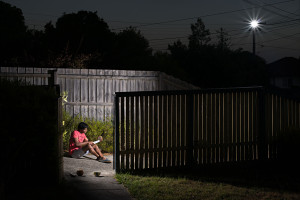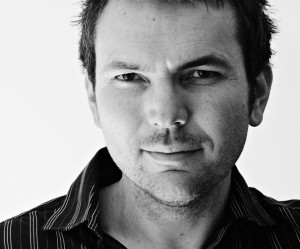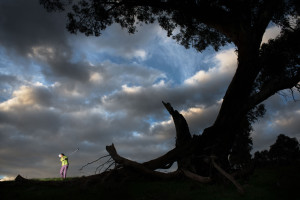Images of freedom

Kumar shaping coconuts into jewellery. Photograph by Andy Drewitt.
Sri Lankan refugee Kumar sits shaping coconut shells into jewellery.
In the half-light of a suburban backyard at dusk he is grinding and carving pieces of coconut into unique pieces of art.
It was a skill he learned locked up in a Sri Lankan prison, suspected but not convicted of being a Tamil Tiger terrorist.
Kumar suffered torture and beatings and he says being able to make his jewellery helped the ordeal.
“I still make time to create these things, because it is a hobby that reminds me of that difficult time that helped make me who I am, and also reminds me of my home,” said Kumar.
Kumar’s story is just one of several that forms a new exhibition exploring the lives of refugees who have overcome tremendous trauma to find solace in the small things and everyday activities.
Melbourne photographer Andy Drewitt’s latest exhibition Freedom, which opened at the Immigration Museum last December, attempts to show what happens after refugees create a new home.
Large-scale images, video interviews and stories share the journeys of 24 people that were forced to abandon their homes and seek asylum in Australia.
Rather than conveying typical themes of refugees looking helpless and desperate, each image empowers the subject through showing them enjoying their interests.
Andy was inspired to capture how refugees now spent their time enjoying life when previously all they could focus on was survival. The significance of being able to tend to a Bonsai garden, or the tranquillity of fishing.
“Set against dark histories of war, persecution and torture, the freedom found in these simple pursuits became altogether profound,” said Andy.
Many of these simple pursuits involve two of Australia’s greatest loves: nature and sport.
May, a Chinese refugee, encompasses both of these with her passion for playing golf.
“Being in the nature makes you feel light and free,” said May.
Though May has not always felt so free, having been persecuted after her father spoke out against the Chinese communist regime in 1957.
May was separated from her family and forced to work on a farm, until after five years she planned her escape.
She chose the darkest night in the lunar calendar and along with four other girls, swam for two days from Tan Zhao to Macau.
In 1978 May came to Australia with her husband and has found peace through playing golf.
In the photograph of her, she is a small figure finishing an elegant golf swing, surrounded by the silhouette of a huge tree and a cloud filled sky.
The semi-stylised photographs play with artificial and natural light to show happy figures in dark surroundings. The gleam of hope the subjects have gained through their hobbies.
The stories explore individual definitions of freedom and how everyday activities can signify belonging.
“Freedom is intrinsic with safety, it means being able to make the choices you want without retribution from other people or the government,” said Andy.

Photojournalist Andy Drewitt.
Andy grew up in Lilydale in the 1980s and was exposed to the hesitations locals had towards immigrants.
“Lilydale was a rural and industrial town, it wasn’t the most progressive place growing up.”
His group in high school consisted of a handful of ‘outsiders’, including a Vietnamese refugee named Phu Trinh. The Trinh family had escaped communism and were the first Asians to settle in Lilydale.
“The Trinh boys copped a lot of racism. It was typical of that type of town, having not been exposed to a lot of things, like a new set of people of arriving.”
“There was that fear of something different. But they had nothing to fear at all.”
Phu is now featured in the Freedom exhibition; a clever use of light and shadow shows him playing baseball, his favourite sport.
Not far from Phu’s photo and story sits Navid’s.
Navid was the 2009 winner of Afghanistan Star, Afghanistan’s version of Australian Idol.
He sits on a wooden fence in rural Australia listening to music through headphones while a plane flies overhead.
Everything around Navid is tinged with grey as he stares into the distance, thinking and listening.
After winning the TV talent show Navid become so popular that the Taliban saw him as a threat.
Extremists made several threats to his life and tried to kill him, shooting him twice in the chest and shoulder.
Fearing for another attack on his life, the pop star was forced to flee to Australia with his family in 2013.
Since starting as a journalist twenty years ago Andy has told many stories like Navid’s, often using refugee and migrant issues as themes in his photography.
“I felt frustration with the way the media was representing immigration and refugee issues. It’s reactionary and demonises those seeking safety.”
“I was interested in creating a balance, showing positive stories that put a face to the debate instead of just a being a number in a statistic.”
His current exhibition introduces a human dimension that is often absent from debates around immigrant and refugee issues.
“When I started out as a journalist, refugees and immigrants were shown as a problem that needed to be dealt with in a particular way.”
“Photographs showed refugees arriving on boats looking haggard and surrounded by officials. There’s very little to show what happens afterwards, the happy faces that say ‘this is what safety provides’.”
Freedom poetically shows how a life can change through finding safety, and in doing so puts a face to the often-faceless debate.
“My hope is to present the truth about an issue that has been informed by myth.”
Freedom is showing at the Melbourne Immigration Museum until June 15th, before running at Maroondah Federation Estate from June 20th to September 5th.
Ruby Brown
AMES Staff Writer













